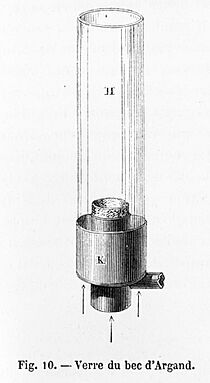Argand lamp facts for kids

The Argand lamp is a special kind of oil lamp. It was invented in 1780 by a person named Aimé Argand. This lamp was much brighter than older lamps, giving off light equal to 6 to 10 candles! It also burned its candle wick and oil more completely. This meant you didn't have to trim the wick as often.
In France, this lamp is sometimes called "Quinquet." This name comes from Antoine-Arnoult Quinquet, a pharmacist in Paris. He helped make Argand's idea popular in France. Some people even say Quinquet added the important glass chimney to the lamp.
Contents
How the Argand Lamp Works
The Argand lamp had a unique design that made it so bright. It used a wick shaped like a tube or sleeve. Air could flow both through the middle of this wick and around its outside. This air then went up into a glass chimney. The chimney helped the flame stay steady and pulled more air into the burner. This extra air made the oil burn much better and brighter.
What Fuel Did It Use?
Argand lamps used different kinds of oil as fuel. These included whale oil, seal oil, colza (a type of rapeseed oil), olive oil, or other vegetable oils. The oil was stored in a tank above the burner. Gravity helped the oil flow down to the wick.
Challenges with the Design
One problem with the first Argand lamps was that the oil tank had to be higher than the burner. This was because the thick, sticky vegetable oil couldn't travel far up the wick on its own. This design made the lamps a bit top-heavy. It also created a shadow on one side, away from the flame.
Later lamps fixed this problem. The Carcel lamp, invented in 1800, used a clockwork pump to move the oil. This allowed the tank to sit below the burner. The Moderator lamp, made in 1836, used a spring to push the oil up.
The same smart burning idea from the Argand lamp was also used for cooking. It gave off a lot of heat without making much smoke.
History of the Argand Lamp
The Argand lamp was shown to Thomas Jefferson in Paris in 1784. He said it gave off "a light equal to six or eight candles." This shows how impressive it was at the time!
These new lamps were more complicated and cost more money than older, simpler oil lamps. So, at first, only wealthy people could afford them. But soon, they became popular with the middle class and even less wealthy people. Argand lamps were made in many beautiful designs and quickly became popular in America. They were even used as lights on stages in theaters.
The Argand lamp was the best lamp available until about 1850. That's when kerosene lamps started to appear. Kerosene was cheaper than vegetable oil. It also produced a whiter flame. Plus, kerosene was a thin liquid, so it could easily travel up a wick. This meant kerosene lamps didn't need complicated parts to feed the fuel to the burner.
See also
- Bude-Light: a very bright vegetable oil lamp that works by introducing oxygen into the center of an Argand burner.
- Lewis lamp


